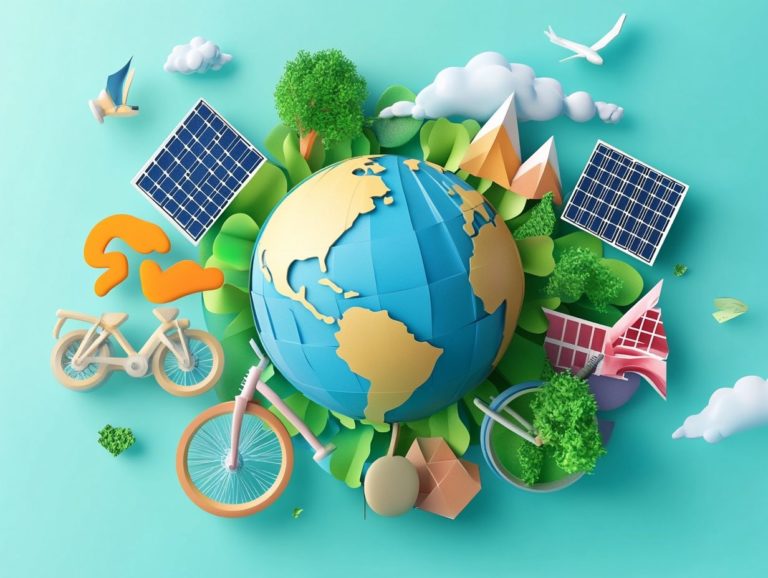The Importance of Choosing Public Transport
Public transport plays a vital role in shaping your cities and communities, providing a sustainable alternative to driving.
As you weigh the benefits from environmental and financial advantages to the enhancement of social connections and health benefits it s essential to recognize the challenges that come with it, such as accessibility and reliability.
Let s dive into how you can maximize your public transit experience while also exploring innovations that promise to elevate its future.
Discover how opting for public transport can not only transform your daily commute but also positively impact the world around you.
Contents
Why Choose Public Transport?
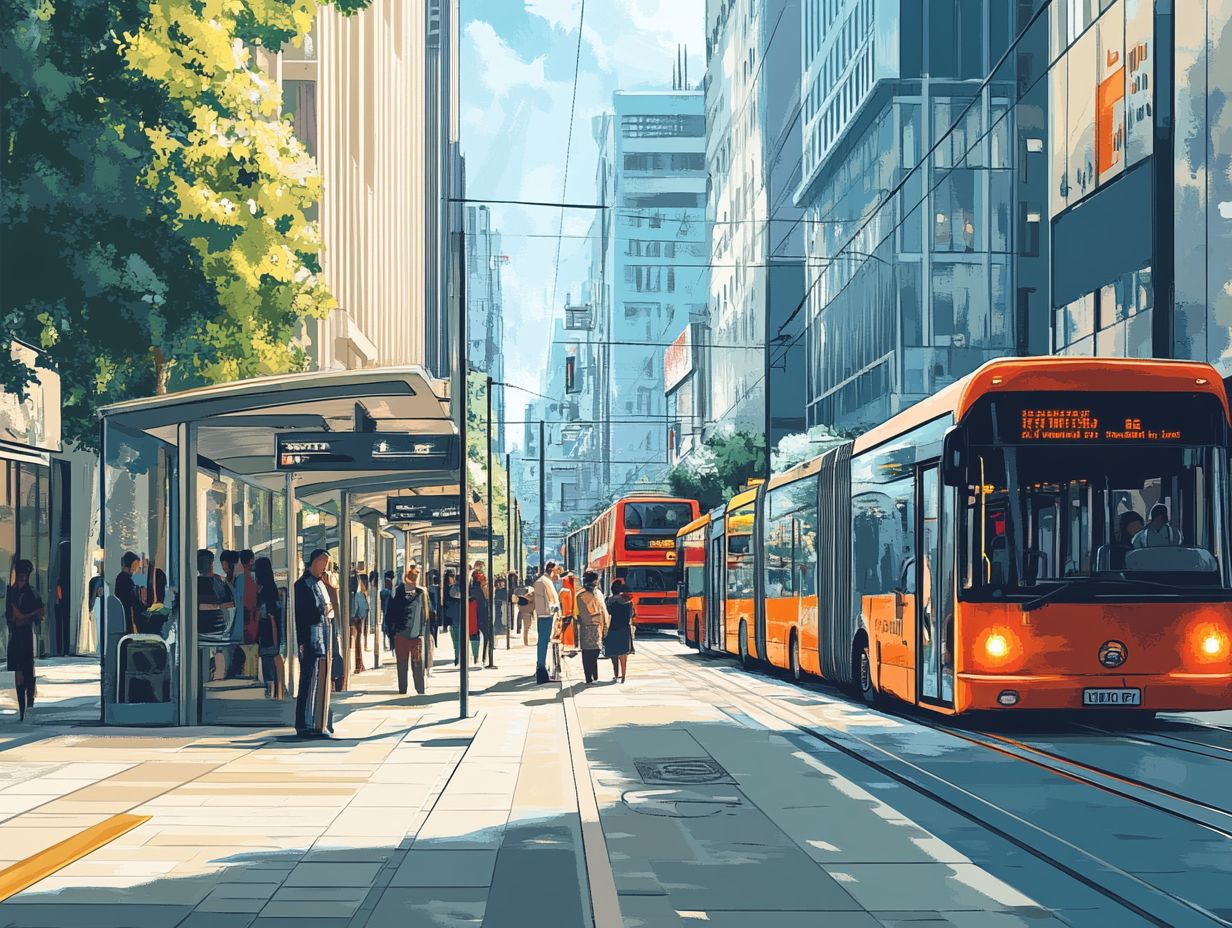
- Choose public transport to cut down on carbon emissions and improve air quality for future generations!
- Save money on gas, parking, and maintenance fees, allowing you to allocate funds towards other important expenses!
- Use public transport to encourage community connectivity and foster a sense of social responsibility!
Defining Public Transport and Its Role in Society
Public transportation, often called mass transit, is a cornerstone of urban planning and societal infrastructure. It facilitates the movement of pedestrians and cyclists within cities while reducing reliance on private vehicles.
By offering cost-effective and ways to travel that use less energy, public transit enhances community accessibility and connects diverse urban areas, significantly impacting the economy and sustainability of metropolitan environments. Moreover, it plays a crucial role in reducing traffic jams and pollution, making it essential for combating climate change and improving air quality in your community.
The various forms of public transport buses, light rail systems, and subways not only streamline your commute but also foster a sense of community among riders. These modes of transport are particularly vital for those without vehicles, ensuring everyone has access to employment, education, and essential services.
By promoting greater use of public transport, cities can dramatically reduce their carbon footprints, leading to cleaner air and healthier urban living. Investments in public transportation spur job creation and stimulate local economies, proving that public transit is not just a convenience but a fundamental element of sustainable urban growth.
Benefits of Choosing Public Transport
Opting for public transportation presents a wealth of benefits that go beyond mere convenience; it significantly enhances environmental health, personal finances, and community well-being. By reducing pollution and lowering greenhouse gas emissions, public transit systems provide a sustainable answer to urban mobility issues.
The financial advantages such as savings on vehicle ownership, fuel, and maintenance make public transport a savvy choice for commuters like you. The health benefits tied to reduced traffic congestion and improved air quality underscore how embracing mass transit supports your individual well-being while contributing to the overall vitality of communities, creating a more sustainable and livable urban landscape.
Environmental Benefits
Public transportation is key to protecting our environment. It significantly cuts carbon emissions and improves air quality in cities.
By choosing mass transit, you help lower emissions per passenger compared to private vehicles. You re supporting sustainable mobility and helping cities achieve pollution reduction goals.
As urban areas continue to grow, efficient public transit systems have become even more essential. They provide a cleaner alternative to the traditional car-centric approach.
Cities investing in rail and bus networks can cut greenhouse gas emissions by up to 45% in just ten years. Public transport encourages fewer cars on the road, leading to more green spaces and cleaner air.
Take San Francisco, for example. The city has seen significant drops in nitrogen dioxide and particulate matter levels due to dedicated bus lanes and an expanded subway system. These improvements promote sustainable urban planning and elevate your quality of life.
Public transportation is vital for creating healthier, climate-resilient communities. Join the movement towards cleaner air!
Financial Benefits
Public transportation offers significant financial benefits for you and the entire economy. It provides a cost-effective alternative to owning a car.
By using public transit, you can save on fuel, parking, and maintenance, allowing you to spend your money more wisely.
The economic impact of public transportation includes job creation and increased access to employment opportunities. This promotes a healthier local economy.
When more people use public transit, air quality improves and traffic congestion decreases. This benefits everyone in the community.
Cities that invest in robust public transport infrastructure often see a boom in real estate development. Properties near transit hubs become more desirable, boosting local businesses and encouraging new ventures.
In essence, the symbiotic relationship between public transportation and economic health highlights its crucial role in fostering sustainable urban living. Get on board today!
Social Benefits
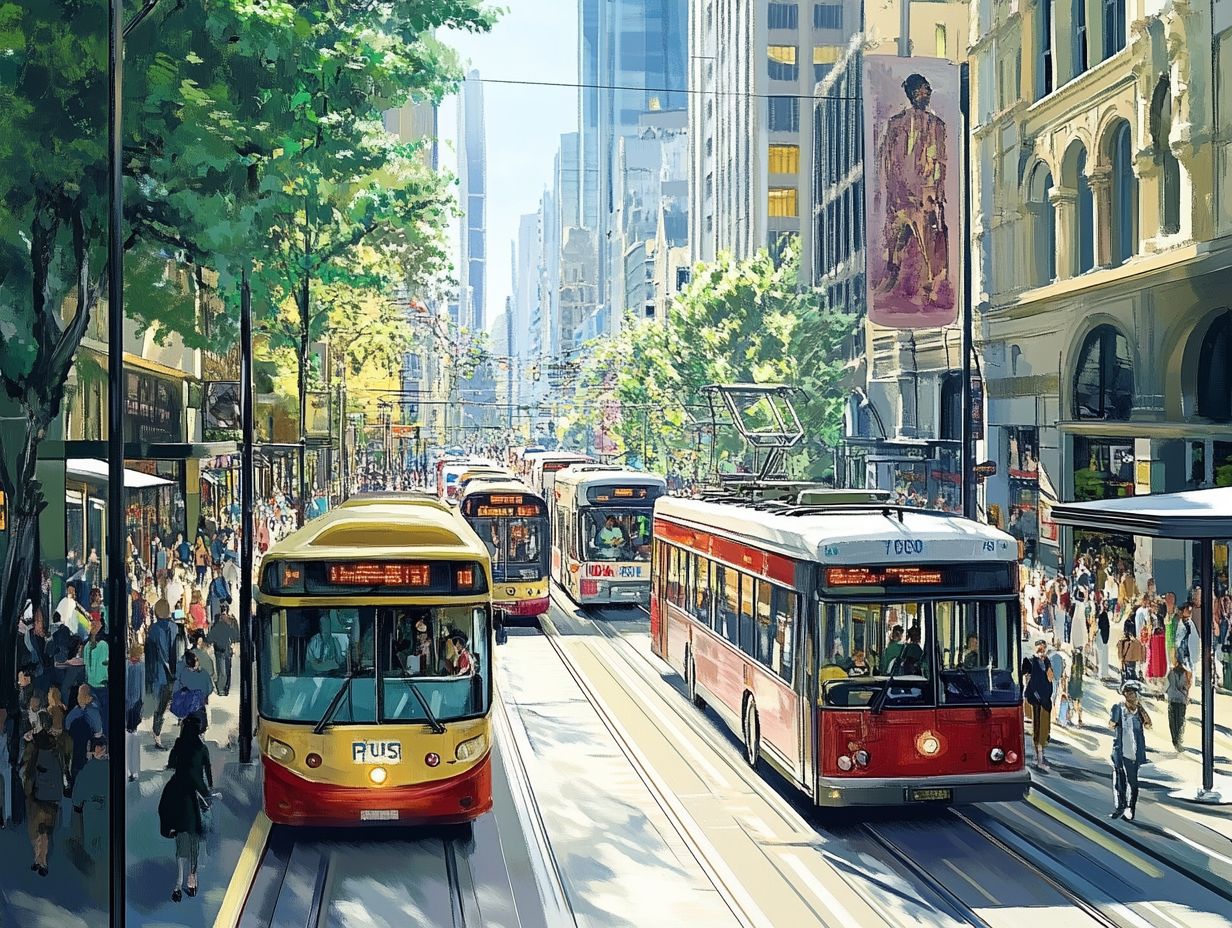
Public transportation provides many social benefits. It improves community access and quality of life, especially in cities.
By ensuring reliable and affordable transportation, public transit allows everyone, including those without cars, to engage in society fully.
This access leads to better health outcomes by reducing isolation and promoting social interaction. It also enhances safety by easing traffic congestion.
Effective urban planning that includes public transit is crucial for building inclusive communities where everyone can thrive.
These systems make it easier for you to access essential services such as healthcare, education, and jobs. They also foster civic engagement by connecting diverse populations.
Using public transit helps cities reduce their carbon footprint. This leads to a healthier environment for everyone.
When urban planners prioritize these systems, they create vibrant, interconnected spaces that meet the needs of all citizens. Together, we can pave the way for lasting positive change!
Challenges of Using Public Transport
Public transportation provides many benefits but also faces challenges that can affect how well it works and how easy it is to use in cities.
Issues like disability access, reliability of the transportation systems, and general service quality can significantly impact user experience. These factors may discourage people from using mass transit.
Additionally, community worries about safety and the quality of infrastructure can create more complications for public transport.
This situation calls for focused efforts from city planners and government bodies to directly address these challenges and make public transit more appealing.
Accessibility Issues
Accessibility issues in public transportation create significant barriers for many, especially for those with disabilities. This limits their ability to navigate cities and participate in community life.
When infrastructure is lacking such as missing ramps, elevators, or clear signs it restricts access to public transit and creates an unfair situation where some people can t get around as easily as others.
It s essential to address these challenges to ensure that public transportation serves everyone, promoting inclusivity and equal opportunity.
For example, many bus stops don t have proper curb cuts, making it nearly impossible for individuals using wheelchairs or mobility aids to board safely.
Similarly, trains often offer limited boarding help, leaving people with disabilities waiting too long and highlighting the need for safety in public transit systems.
While current regulations aim to improve accessibility, they often struggle with enforcement and thorough implementation.
To create a genuinely inclusive environment, we must enhance existing infrastructure like adding more automated doors and having staff available to assist riders and include individuals with disabilities in the planning process.
Collaboration between government agencies and community organizations can lead to innovative solutions, ensuring equitable access to transportation services for all.
Reliability Concerns
Reliability concerns in public transportation can greatly affect your satisfaction and may lead you to choose private vehicles instead.
When schedules are inconsistent, delays are frequent, and service quality is low, it s no surprise that many commuters might avoid public transit.
This shift leads to more traffic congestion and can harm our environment. Tackling reliability issues is essential for building your trust in public transportation and promoting sustainable mobility in urban areas.
Moreover, insufficient service frequency can leave you waiting longer for rides. If maintenance isn t done consistently, the chances of vehicle breakdowns increase, causing even further service disruptions.
This creates a view of public transportation as unreliable, making personal vehicles appear more appealing.
These perceptions not only affect your commuting choices but also pose challenges for city planning and environmental goals.
By improving reliability, public transportation could see increased usage, reduced emissions, and a more vibrant community thriving on efficient, eco-friendly transport solutions.
How to Make the Most of Public Transport
Maximizing your experience with public transport requires a keen understanding of various strategies and tips for efficient and comfortable travel, especially in busy urban areas.
Familiarizing yourself with the routes, schedules, and available resources can help you optimize your journeys and significantly reduce waiting time.
Knowing the amenities provided by public transit can enhance your comfort and convenience, making public transport your preferred choice for your daily commute.
Tips for Efficient and Comfortable Travel
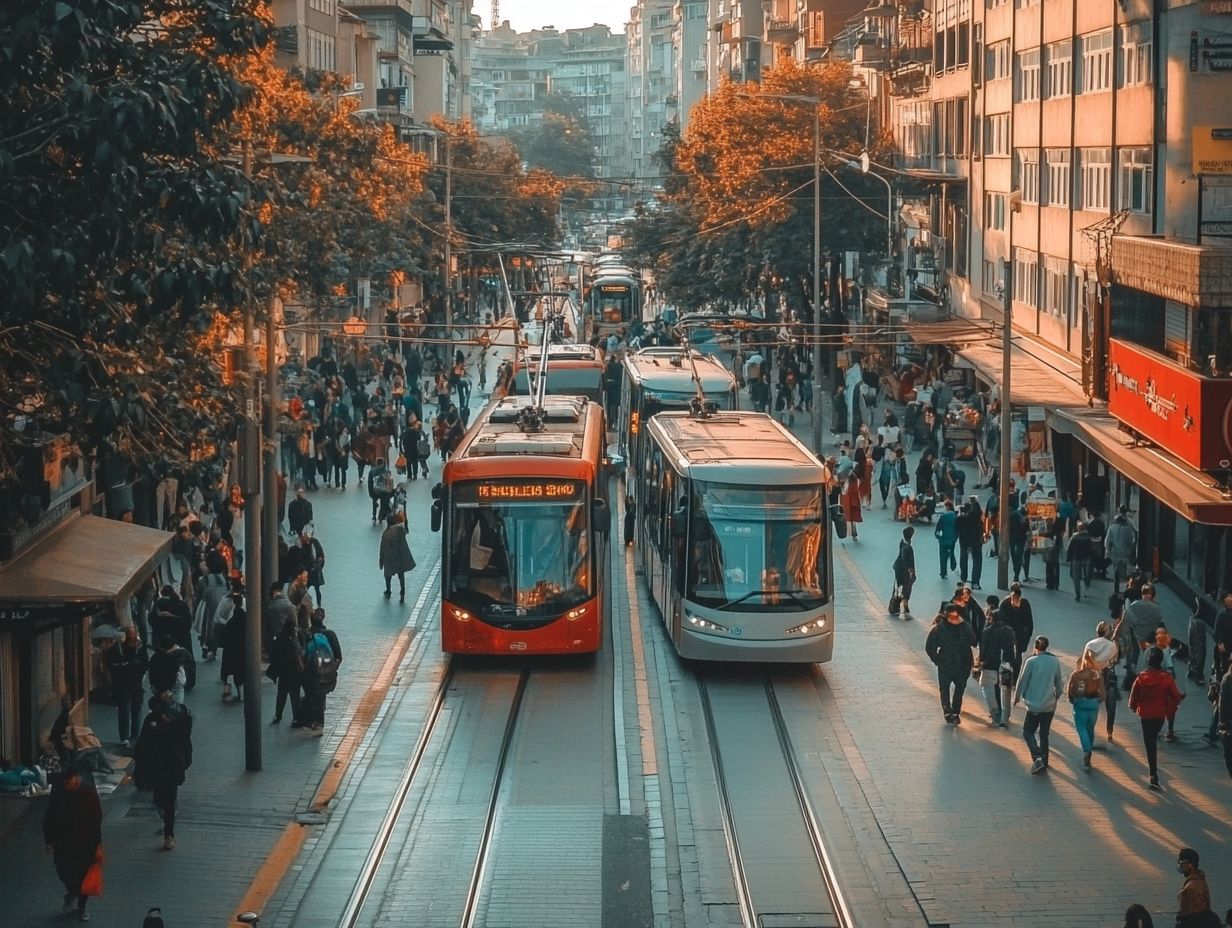
To ensure your travel via public transport is both efficient and comfortable, implement practical tips that elevate your overall experience. By understanding peak travel times and utilizing mobile apps for real-time updates, you can significantly enhance your travel.
Choose your seat wisely for comfort. Carry essential items with you and be mindful of the comfort amenities offered by public transit systems. This can transform your journey into something much more enjoyable and less stressful.
One valuable resource is transit apps, which provide critical information on delays, cancellations, and alternate routes. These tools enable you to make informed decisions, allowing for a smoother experience.
Take advantage of real-time scheduling to minimize waiting times and reduce frustration. Download multiple apps for various transit services in your area; different providers often come with unique features that can enhance your travel.
Stay tuned to local transit news for the latest updates on any changes in service or potential upgrades. This ultimately leads to a more convenient and pleasant journey.
Future of Public Transport
The future of public transport is set for transformation, driven by advancements and innovations that elevate better services, easier access, and eco-friendly options within transportation systems.
Explore emerging technologies like electric buses, smart ticketing solutions (using your phone to buy tickets easily), and real-time tracking systems. These innovations promise to revolutionize public transit, offering eco-friendly options alongside enhanced user experiences.
As cities adapt to changing mobility demands, integrating sustainable practices will be crucial in defining the next generation of public transportation. This evolution benefits communities and plays a vital role in safeguarding the environment.
Advancements and Innovations
Recent advancements in public transport usher in a new era of sustainable mobility. Technologies like electric vehicles and smart ticketing systems enhance your experience while reducing carbon emissions and alleviating traffic congestion.
By embracing these solutions, public transport systems can become more efficient, environmentally friendly, and accessible to everyone. This ultimately reshapes how you navigate urban landscapes.
The integration of electric vehicles marks a shift towards greener alternatives, eliminating harmful emissions and significantly reducing noise pollution. This creates a more pleasant environment for you and your community.
Smart ticketing systems streamline your boarding process, encouraging residents like yourself to choose public transport over private vehicles.
Innovations such as real-time tracking and data analytics foster greater community engagement. They enable transport authorities to tailor services based on the changing needs of users like you.
Collectively, these advancements are not just technological upgrades; they represent a holistic approach to fostering sustainable urban living that benefits everyone.
Frequently Asked Questions
Discover why choosing public transport matters! Choosing public transport is important for several reasons. It helps reduce traffic congestion, air pollution, and carbon emissions. It also contributes to a more sustainable and environmentally friendly transportation system.
How does public transport benefit the community?
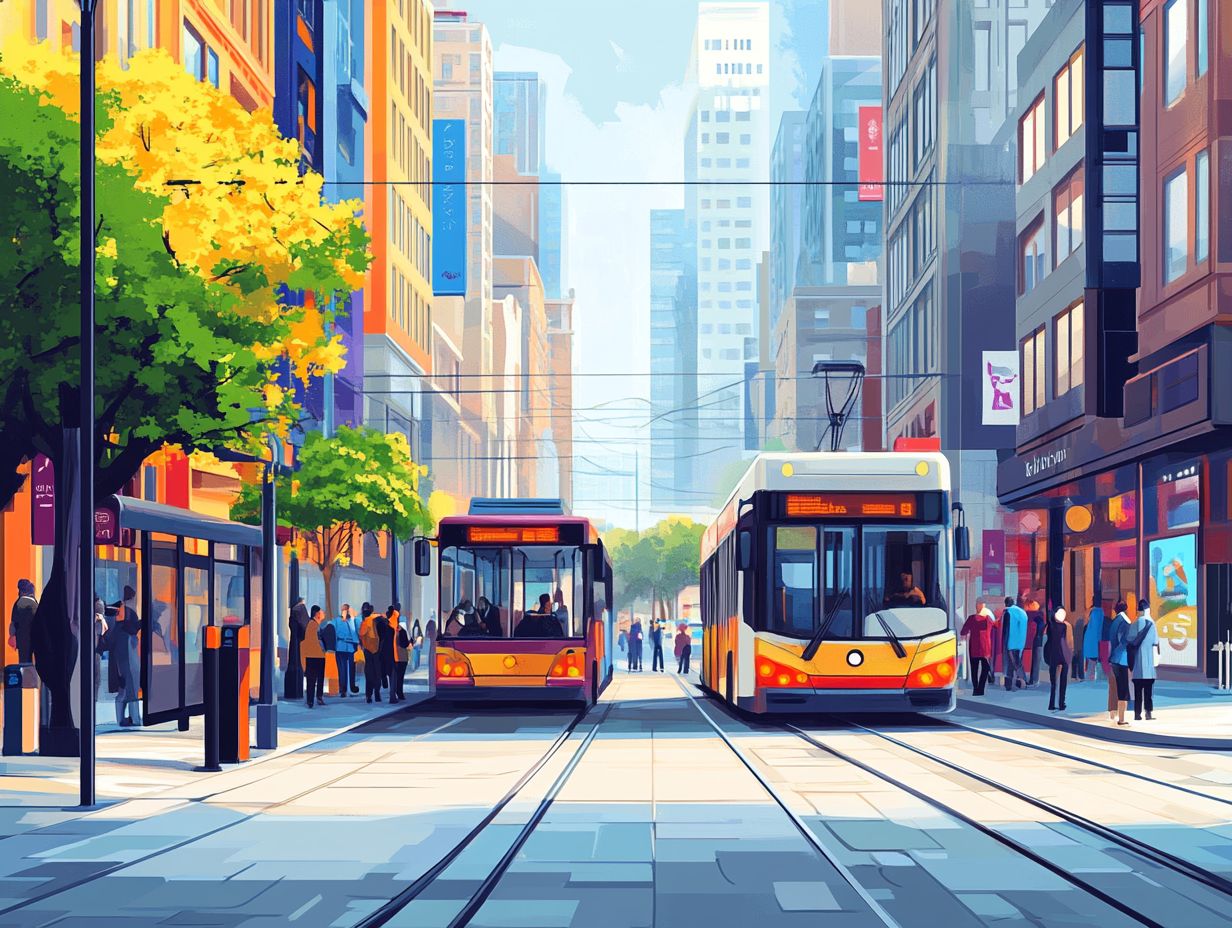
Public transport offers affordable options for everyone in the community, no matter their income or ability. It helps people connect and reduces feelings of loneliness, especially for the elderly and disabled.
What impact does choosing public transport have on the environment?
Using public transport reduces the number of cars on the road. This leads to lower carbon emissions and better air quality, making our planet healthier.
Why is public transport a more cost-effective option?
Public transport usually costs less than owning a personal vehicle. You save on gas, insurance, and parking fees. Many cities also provide discounted fares for students, seniors, and low-income individuals.
How does using public transport benefit personal health?
Using public transport encourages physical activity, like walking to bus stops or train stations. This can lead to better health and lower risks of issues like obesity and heart disease.
What role does public transport play in reducing traffic congestion?
By using public transport, you help cut down the number of cars on the road. This decreases traffic congestion, reduces travel time, and leads to fewer accidents and less stress for everyone.





